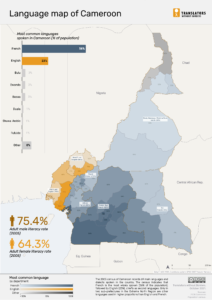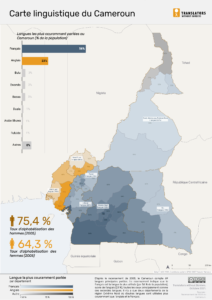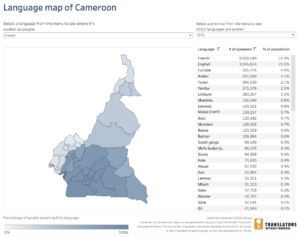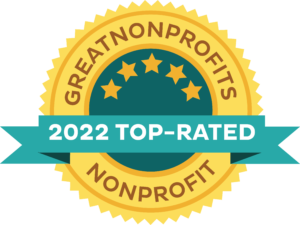The 2005 census of Cameroon records 69 main languages and dialects spoken in the country. The census indicates that French is the most widely spoken (56% of the population), followed by English (23%) — both official languages. Only in two sub-prefectures in the Extreme North Region are other languages used in higher proportions than English and French. The country aims for bilingualism, but according to the census very few (11.6%) Cameroonians are literate in both French and English, and 28.8% are literate in neither.
Most people in the English-speaking Northwest and Southwest Regions speak English or Cameroonian Pidgin English as a second language, to communicate with speakers of other languages. A similar pattern is observed in French usage, especially in the Center and South Regions. Sources other than the census suggest that Fulfulde serves the same function in North and Ewondo, much of the Center, South, and East Regions. However, that isn't reflected in the 2005 census, which only asked specific questions on English and French usage and didn’t distinguish between first- and second-language speakers. The census also asked which national language respondents speak, but allowed only a single answer, making it impractical to quantify the usage of other languages spoken mostly as second languages, like Fulfulde. There is little literature, radio, or television programming in languages indigenous to Cameroon.
The overall literacy rate in Cameroon in 2005 was 69.7%. Literacy rates are markedly lower for women (64.3%) than men (75.4%).
Explore the data by department here.
These maps and datasets are published with funding from the World Food Programme.
Curated datasets
Available on Humanitarian Data Exchange (HDX)
Other sources of language data
Ethnologue
Glottolog
For more information, please contact maps@translatorswithoutborders.org
Maps and resources:
Languages in Cameroon: Static (EN)
Static map highlighting the most common languages spoken in Cameroon. Data is from the 2005 census.
Languages in Cameroon: Static (FR)
Static map highlighting the most common languages spoken in Cameroon. Data is from the 2005 census.
Languages of Cameroon: Interactive (EN)
Interactive map showing the number of speakers and geographic spread of different languages in Cameroon. Data is from the 2005 census.



